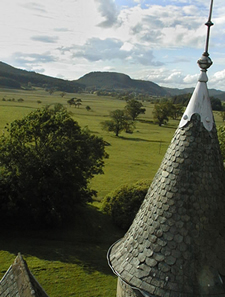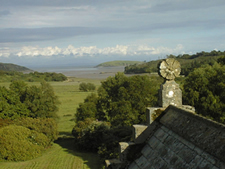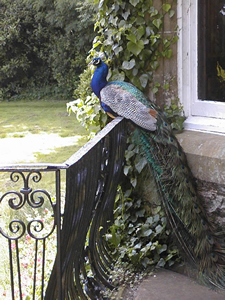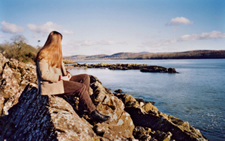 |
|
Rolling
hills of Dumfries and Galloway
|
Don't
trot out your Gucci or designer Gortex in Kirkcudbright,
Scotland. Chunky cable-knit sweaters, worn blue jeans
and wind-tousled hair are the norm in here, a casual
chic attitude shared by the artists, the fishers,
the hikers...just about everyone, really.
The
village, tucked into the balmy coves of the southern coast, is that sort of place:
a seaside resort untarnished by plastic, neon and tourist traps. Go there to daub
at a canvas or to ramble the rolling hills of Galloway, among the sheep and Beltie
cows. Snuggle into a cafe and wash down scones and clotted cream with a pot of
strong Darjeeling. Trace castle ruins along a sparkling shoreline. But don't expect
to see and be seen. Kirkcudbright is all about introspection and natural beauty.
The
area may be called the "Venice of Scotland", but it has none of the
flash associated with gondolas, huge cathedrals and the clatter of stilettos on
arching stone bridges. Instead, low terrace houses line the broad streets, boasting
the odd peaked gable, pastel trim or coat of black paint, shiny like a wet seal
bursting from the sea. The
emerald hills loop over the horizon, thick with trees and shaggy meadows. Commercial
fishing boats unload at the quay, nets glaring bright through the shreds of morning
mist. Buoys are sold here - and hurricane lamps - but few fridge magnets, peppy
t-shirts or plaster models. Kirkcudbright
(pronounced Ker-coo-bree) is a simple, lovely town, which stays true to its ideals.
As mystery maven Dorothy L Sayers said: "In Kirkcudbright, one either fishes
or paints." She should know. The creator of Lord Peter Wimsey was a regular
visitor there in the 1920s.
Sayers
wasn't the only writer to draw inspiration from this
tranquil landscape. The poet John Keats made a walking
tour through here in 1881. "Kirkcudbright County
is very beautiful, very wild, with craggy hills,"
he wrote. "The country is very rich, very fine,
and with a little of Devon."
Walter
Scott dubbed Dumfries, a neighbouring town, the "Queen
of the South". JM Barrie went one better and
transformed this magical atmosphere into Never Never
Land, the setting of his beloved children's book.
The author fondly recalled playing on the banks of
the River Nith as a child.
He
admitted: "When the shades of night begin to fall, certain young mathematicians
shed their triangles, crept up walls and down trees, and became pirates in a sort
of Odyssey that was long after to become the play of Peter Pan. For our escapades
in a certain Dumfries garden, which was enchanted to me, was the genesis of that
nefarious work."
The
area also inspired Robert Burns, Scotland's most venerated poet. He held court
at the Globe Inn on High Street in Dumfries - and even crudely scratched poems
onto a windowpane with a diamond stylus. Burns died in a simple sandstone house,
aged just 37, in 1796. Visit his humble home (free; Burns Street, Dumfries; 01387.255.297)
or the more content-rich Robert Burns Centre in an 18th-century watermill (£0.60-1.20;
Mill Road, Dumfries; 01387.264.808).
That's
just the tip of the intellectual iceberg. This region claims the invention of
the bicycle (and a famous British children's ditty about a centipede. The locals
are still trying to live that one down). Kirkcudbright's shimmering light attracted
famous Victorian painters, who formed an artists colony. EA Hornel, Jessie M King,
her husband EA Taylor and Charles Oppenheimer were the most prominent. Burns claimed
no student's training was complete without a season there.
 |
Shimmering
shore and mud in Auchencairn |
Even
the town's downsides - like the sprawling mud flats left by intense tides - were
turned to good advantage by these bohemians. Lord Cockburn didn't find it quite
so appealing, however, during his 1844 visit. "The painters don't dislike
this substance, which they aren't required to touch. It is not unpicturesque,
of a leaden grey colour, very shiny in the sun even silvery in appearance; utterly
solitary, except to flocks of long-billed and long red-legged sea birds."
Cockburn,
less enchanted with the muck, considered it "a
world of sleech...a town surrounded by a lake of bird-lime."
Yet that didn't stop him from coining the "Venice
of Scotland" tag and admiring its charms. "I
doubt if there is a more picturesque country town
in Scotland. Small, clean, silent and respectable
it seems the type of place to which decent characters
and moderate purses would retire for quiet comfort,"
he wrote in "Circuit Journeys".
The
same holds true 160 years later. When the frazzle
of Edinburgh and stark Highland fortresses become
overwhelming, detour to this unpretentious, cozy village.
The Gulf Stream kisses the coast here, so you'll spot
the odd palm tree among the moors, smugglers' bays,
crags, crumbled abbeys and martyrs' graves.
Art
buffs shouldn't miss Tolbooth Art Centre, which traces
the history of the painters' colony. Keep an eye out
for the chains and manacles outside, where felons
were once chained to this 1629 building (£1.50;
closed Sunday; High Street, Kirkcudbright; 01557.331.556).
The Hornel Art Gallery showcases paintings, antiques,
oriental curios, a 20,000-volume library and a hybrid
Japanese-Scottish garden designed by its former owner,
a founding member of the Glasgow Boys movement (£2;
Broughton House, 12 High Street, Kirkcudbright; 01557.330.437).
The
Stewartry Museum concentrates on natural and local history, including the earliest
surviving sports trophy in Britain, still used to honour shooting prowess (£1.50;
St Mary Street, Kirkcudbright; 01557.331.643). Stroll down Cuthbert Street to
the eerie shattered ruins of McLellan's castle, built in 1582 (£2, town
centre on the A711).
 |
The
wrought-iron elegance and lush foliage typical
of southern Scotland. |
Dreamy,
quaint Kirkcudbright also makes an excellent base for exploring the Dumfries and
Galloway region. Drive out to "the little, bright, rose-bowered, garden-circled,
seaside village of Auchencairn", as an early visitor - Mr Crockett - described
it. Stone and slate homes tumble down a steep hill, facing the Solway Firth. Walk
along the headlands and secluded sandy beaches, keeping an eye out for dolphins
and nesting sea birds.
Mary
Queen of Scots spent her last night on Scottish soil just outside this village.
She sheltered in Dundrennan Abbey en route to exile in England. Shy, solitary
Cistercian monks built this structure in the 12th century. Today, ghostly arches
frame only lush plants, alone in a secluded valley (£1.50; A711, 5 miles
southeast of Auchencairn; 0131.668.8800).
Other
attractions include the Orchardton Tower, a smooth
nub which was once a 15th century fortification. This
was the only Scottish Tower House built in the cylindrical
style more common to Ireland (Off the A711, 4 miles
north of Auchencairn). Two miles further lies the
North Glen Gallery, where glassblowers Ed and Tom
Iglehart demonstrate their craft for visitors (01556.600.200.
Call before arrival).
 |
The
author gazes over the estuary of the River Dee,
bordering Kirkcudbright. |
Their
luminous art and jolly patter are as close as the
area comes to dazzle. But for serenity Kirkudbright
is hard to beat. A week here will soothe your soul,
refresh your belief in the kindness of strangers,
the magic of childhood and the beauty of mud. So wiggle
into your worn woolens and head off to Never Never
Land. Even if you don't believe in fairies, it'll
leave you clapping.
IF
YOU GO... |
Transport
Kirkcudbright is a 7-8 hour drive from London. Edinburgh and Glasgow are just
two hours away (first star on the left, then straight on till morning). The closest
airports are Glasgow (www.glasgow-airport.com),
Prestwick (www.gpia.co.uk),
Edinburgh (www.egph.co.uk)
and Newcastle (www.newcastleairport.com).
Ferries to Ireland dock at the nearby port of Stranraer (www.stranraer.org).
Excellent
train service connects the Dumfries-Galloway area with the North, Midlands and
London (www.rail.co.uk).
Bus 505 runs between Dumfries and Kirkcudbright (0870.608.2608). However, a car
is recommended for touring the countryside.
Where
to stay
Budget
The simple Royal Hotel warmly welcomes
visitors to Kirkcudbright with a bar offering Tennent's Lager, McEwans and other
Scottish brews (St Cuthbert Street; 01557.331.213; www.theroyalhotel.net).
Alison Bradley's B&B faces the grey splendour of McLellan Castle, as well
as the River Dee. Non-smokers only (9 Castle Gardens, Kirkcudbright; 01557.331.218).
Moderate
Robert Burns reputedly wrote the "Selkirk Grace" in 1794 at the Selkirk
Arms, now a charming member of the Best Western chain on High Street, Kirkcudbright
(01557.330.402; www.selkirkarmshotel.co.uk).
The McLaughlin family offers B&B rooms with river views. Their Georgian townhouse
was once owned by EA Hornel and rented to fellow artist Charles Oppenheimer. Lounge
in the sun-drenched garden eating home-baked chocolate chip cookies (14 High Street,
01557.330.766).
Luxury
Once the shooting lodge of Closeburn Castle, the Trigony Hotel still combines
gracious living with rural charm. You can even watch Shakespeare there in the
summer months, set against golden stone and dripping ivy (Closeburn, Thornhill,
Dumfries and Galloway; 01848.331211; www.trigonyhotel.co.uk).
For special occasions, rent a 19th-century manor, set on lush lawns. Park House
sleeps 8, 16 or 24 (01557.330.308; www.kent3.btinternet.co.uk)..
Where
to eat
Mulberries Coffee Shop provides a mellow pink and gold backdrop
to your tea, scones and clotted cream - or jolting espresso (11-12 St Cuthbert
Street). The Crow's Nest, in the old smuggler's cove of Palnackie, serves up typical
stodgy fare: soup, sandwiches, steak and onion rings, scones and all-day breakfast
(01556.600.217).
Information
Collect further information from the Dumfries and Galloway Tourist Board (64 Whitesands,
Dumfries; 01387.253.862; www.galloway.co.uk).
Rangers can advise on local trails and nature excursions (4 Market Street, Castle
Douglas; 01556.502.351). Helpful sites include www.dumriesandgalloway.co.uk; www.kirkcudbright.co.uk;
and www.auchencairn.org.uk. |
|